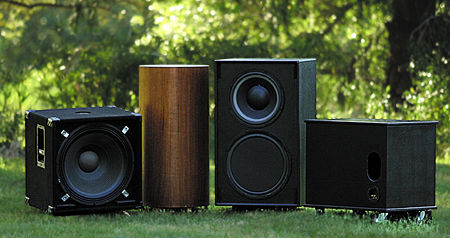Way Down Deep II
Details on the testing methodology can be found here.
Part One of this article can be found here.
Part Three of this article can be found here.

If your idea of a subwoofer is a 12- or 15-inch driver firing from the front of a box that has an amplifier and power cord on the back, you're in for some surprises in this, the second of a three-part survey. One of the four suwoofers reviewed here is belt-driven; another could be said to be at least partially water-driven; another breaks with convention by using a pair of nested cylinders—concrete pouring forms, in fact—as its enclosure; and the fourth deploys the burliest driver in the survey: a whopping 21-inch unit that, curiously, produces the limpest deep-bass response, unless partnered with its matching outboard processor.
Unlike the four active subs reviewed in Part 1 (from Revel, Kleiss, Genelec, and Wilson Audio Specialties), each subwoofer here is passive. That is, each requires that the user supply a suitable power amplifier. Because the choice of power amp could otherwise be a limiting factor, I drove each of the four subs with a Swedish-made Lab.gruppen fP6400, a 2-channel, high-current, professional-type unit with continuous power ratings of 1300W per channel into 8ohms, 2300Wpc into 4ohms, and 3200Wpc into 2ohms (www.labgruppe.se).
For the listening sessions, I also rotated in something more familiar to audiophiles: a Parasound A21, a John Curl–designed stereo unit offering 250Wpc into 8ohms and 400Wpc into 4ohms (www.parasound.com).
Out of Time
While a detailed discussion of group delay is beyond the scope of this article, Bag End asserts that lower group delay translates into audibly better bass. And indeed, the 11 other subs in this survey had measured group delays two to six times higher than that of the S21E. But no reports of controlled double-blind listening tests of time-domain issues in the subwoofer range have appeared in the likeliest places (including the Journal of the Audio Engineering Society), and the few credible reports on the audibility of group delay have not considered frequencies below several hundred hertz. For many months, I ran level-matched comparisons using dozens of challenging tracks, from soundtrack spectaculars to more subtle classical and jazz numbers, without finding a qualitative difference that I could confidently ascribe to anything other than amplitude response, distortion, and power-compression factors.—KY
Note: Figs. A1 through D5
Technically referred to as spectrograms, the waterfall graphs shown here provide a picture of how deep and loud each subwoofer managed to play several particularly treacherous 10-15-second clips from a few selected soundtracks and CDs. The main speakers were disconnected and the subwoofer level increased to a point just 1dB below the onset of audible distortion—whether hashiness, fuzziness, fluttery noises, cardboardy thwock sounds, or other noticeable fault. The result was recorded with the microphone 2m away from the subwoofer. In these displays, time flows downward, like water, with each faint white horizontal line marking 1 second. The frequency range spans from 0Hz on the far left to 80Hz on the far right. The color indicates playback volume over a 40dB range, from dark blue (very soft), increasing through green, yellow, and finally to burgundy (very loud).
- Log in or register to post comments






























































